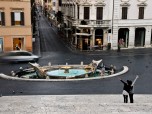The Pyramid of Cestius is a 2,000 year old pyramid that stands close to the Porta San Paolo in Rome. It has remained in remarkably good condition because it was used as part of the city’s fortifications. Although its design is based on Egyptian pyramids, it is both steeper and sharper, something which influenced medieval and early modern artists. It is now the only pyramid of its kind in Europe.
History
After Egypt was conquered by the Romans in 30 BC, a wave of interest in all things Egyptian spread across the Italian capital. Romans were inspired to construct a large number of copies of Egyptian structures. Among the original constructions were two pyramids, of which this is the only example to have survived. The other, the Pyramid of Romulus, was destroyed in around 1500 as its marble was used in the fabric of St. Peter’s Basilica.
It is estimated that the pyramid was built between 18 and 12 BC as the tomb of Gaius Cestius. He was prominent in the Septemviri Epulonum, one of the four great Roman religious corporations, as well as a wealthy merchant. Almost nothing is known of the man himself due to repeated ransacking of the tomb over the centuries. The site has also changed enormously. In Roman times, it stood far away from the city’s center, whereas it is now in a very busy part of Rome.
Design and Appearance
The pyramid is mostly made of a mixture of cement and brick, with a white marble coating. In its original form, there were a number of interior frescoes showing scenes from life, but little of this art now remains. However, detailed descriptions survive thanks to travelers’ notes. The main pyramid’s survival was ensured when it was incorporated into the Aurelian Walls of Rome in the second half of the third century AD.
Compared with the existing pyramids of Egypt, the Cestian structure is considerably steeper. It is possible that this disparity resulted from the use of garbled information regarding Egyptian practice, but it may also have been a deliberate design choice. One reason for the difference may have been the Roman invention of concrete which gave the engineers much more flexibility in construction. Another suggestion is that the pyramids near Jebel Barkal in Nubia, which do rise rather steeply, may also have been influential on Roman builders.
Modern Developments
Because of the scale of this pyramid and its Romulan cousin, they became the subjects of a number of legends in medieval Italy. Among the most popular of these were those which associated the two structures with Romulus and Remus, the legendary founders of the city. It was not until the tomb itself, together with its inscriptions, were rediscovered in the 17th century that the question of the pyramid’s actual origins was finally settled.
The Pyramid of Cestius has received two significant restorations, although the first in the 1600’s was carried out, as was usual for the time, in a way that did not necessarily respect its history. A much more careful and respectful restoration of the pyramid was completed in 1999. The tomb itself is now under special protection because of its unique status and is not normally open for public visitation.





































